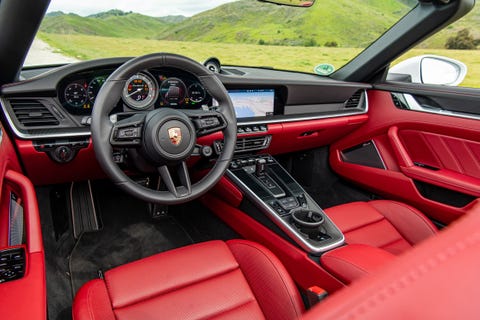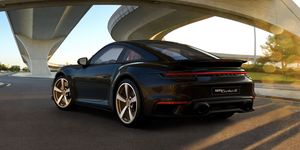For a moment, put aside thoughts of speed, adhesion, and power. Don’t think about heritage, beauty, or price. Before we get to that, we’d like you to consider how tremendously good the 2021 Porsche Turbo S is when it’s going slow. Whether its urban trawling, suburban errands, or a lackadaisical back-roads tour, this is the best really fast car there is when velocities sink to a crawl.
When tasked with slowness, Lamborghinis and Ferraris champ at the bit, making their discontent with your pace known by barks, cackles, and fire breathing. Corvettes can fake easygoing pretty well, especially if you’re a fan of the interior design and forgiving of fit and finish. And then there’s the 911 Turbo S Cabriolet, a car that’s utterly placid in the right lane. And the interior is attractive and crafted with care down to the last stitch on the leather-wrapped instrument panel.
Of course, with 640 horsepower on tap from its twin-turbocharged 3.7-liter flat-six, the 911 Turbo S Cabriolet is always ready for you to call a blitz. According to Porsche, it’ll propel itself to 60 mph in 2.7 seconds, and it won’t stop until it hits 205 mph, presumably with the top up. But most of the time, for most drivers, what matters is that this is a car that does low-speed better than all other high-speed cars, and that’s what makes for a great and useable daily driver.
Porsche introduced the capital-letter 911 Turbo model way back in 1975. But it wasn’t until the 1980s that the company added Targa and Cabriolet models. The part-roof and drop-roof models were rare, although the Turbo’s wider body with massively suggestive fender flares looked particularly mean on the open-top models. Porsche’s reason for developing the 911 Turbo was to homologate a turbocharged version of the 911 to go racing. And convertibles aren’t for racing. So, there’s been a certain tension within the mission of a 911 Turbo convertible. With the new 992-generation Turbo S, there’s a feeling that the tension has slackened a bit.
With new, larger variable-geometry turbos heaving into a new engine with a slightly shorter stroke than the 991’s version, the assumption may have been for a somewhat more temperamental, nervy, on-edge driving experience in the new ogre. In addition to the new turbos that are now mirror images of each other, GT2 RS-inspired exhaust manifolds, and new intercooler routing, some credit has to go to the engine electronics that make it all play together. Unlike the simple fuel injection of the ’70s and ’80s Turbos, today’s engine-management computers get variable valve timing, variable-intake valve lift (a first for the Turbos), turbo-boost management, and precisely metered direct fuel injection to dance in a way that can handle all-out acceleration and puttering along at low speeds in eighth gear.
That eighth gear is new to the Turbo. Previously, the Turbo had a seven-speed dual-clutch (PDK in Porsche-sprache) automatic transmission. Like its predecessor, there’s no manual in this generation. Fun fact: That’s twice the number of gears the 911 Turbo had until 1989. The close spacing of the gears means that even going slow the engine remains relaxed but ready to respond. Unlike many modern automatics, the new PDK doesn’t constantly rush into the highest possible gear to chase fuel economy. It remains in or close to the right gear for shooting the gaps in traffic. Granted, with 590 lb-ft of peak torque available between 2500 and 4000 rpm the Porsche could probably whip up serious acceleration with a two-speed Powerglide.
And all that mechanical goodness is embedded in a structurally impregnable, if roofless, aluminum-intensive unibody. It’s actually more than just aluminum and steel, the cabrio also has its share of magnesium, all placed where it makes the most sense. Maybe if there were a 911 Turbo S coupe to drive alongside it, there might be a noticeable difference in structural integrity. Short of that, the Cabriolet gives no indication that the top has been shorn off. There is, however, a weight penalty for the convertible’s additional belts and braces. According to Porsche, the droptop is 154 pounds heavier than the coupe.
With the arrival of the 992 series, the 911 interior has evolved into an environment that’s wholly modern. A large, centered conventional tachometer has digital display wings on either side of it that almost float behind the steering wheel. These wings usually display digital versions of familiar 911 gauges. But change the drive mode, and the displays will optimize for the mission ahead. Vehicular status information also can be called up on them when requested. In the middle of the instrument panel is a 10.9-inch touchscreen with haptic feedback to show navigation, entertainment, and a number of other vehicle systems and settings.
About the worst that can be said about the interior is that the transmission selector is kind of puny. Yes, it’s an electric switch, and maybe there’s a virtue in that it doesn’t fake being mechanically attached to something. But still, wouldn’t it have been satisfying to have some sort of “click” or “snick” or other “ick” that gave some satisfying feedback to the driver?
In Normal driving mode, the exhaust is subdued and the ride quality outstanding, considering the massive 255/35R-20 front and 315/30R-21 rear tires. Unlike the coupe we drove a few weeks ago, this convertible rides on the standard Turbo S suspension, not the optional Sport suspension that lowers and stiffens the springs and adaptive dampers. It’s not a ’70s Lincoln, but it also won’t make you shudder whenever you hit an expansion joint.
The convertible top is operated with a single switch that automatically latches and unlatches the roof. Its operation is both easy and quick. It’s a foolproof operation that can be completed even when the car is moving at up to 31 mph. The system is smart enough to drop and raise the rearward quarter windows with the top. That keeps the owner from leaving them up when the top is down, something we lovingly call Shark mode.
A power-operated wind deflector raises up to reduce buffeting at speed. It calms turbulence to the point that the driver and passenger can have a nice chat about why you’re driving so fast. But when it’s deployed, it wipes out the usefulness of the human-carrying capability of the rear seats, which admittedly isn’t very much.
Now, forget about slow. Holy Stromboli, this thing is a beast when it is allowed to be. Put in Sport or Sport Plus modes, the whole mood and countenance of the car changes. In Sport Plus the front spoiler drops down, the rear spoiler lifts up to aid in stability, and the exhaust voice drops an octave. Using the launch control system, Porsche has the Cabriolet rocketing from zero to 60 mph a tenth of a second behind the coupe. C/D‘s testing usually proves that Porsche is conservative in its estimates. It’s likely doing the deed in about 2.6 seconds, maybe even 2.5 seconds. Hell, it might be ripping right beyond the speed of light and going backward in time so that it hits 60 before it even launches. If it does that it might even make you look younger. Wait, isn’t that why some people buy these things?
Source: Reviews - aranddriver.com











